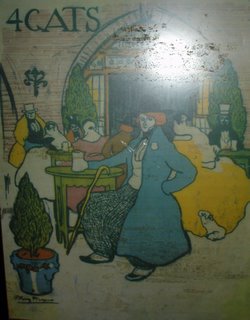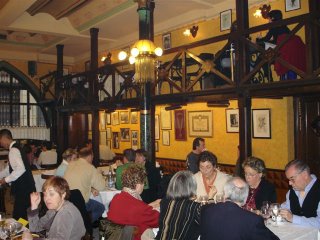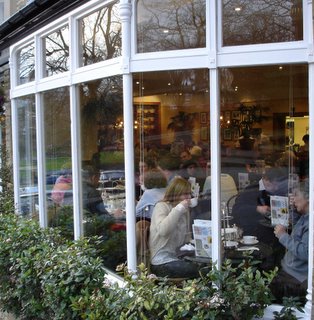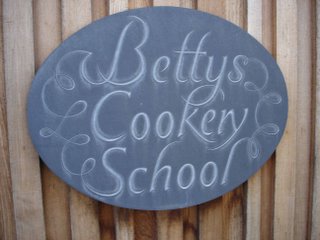 Further to the previous article about Bettys in Harrogate, readers might be interested to learn about what a day at the Bettys Cookery School is like and, in so doing, be part of Eating History in the making!
Further to the previous article about Bettys in Harrogate, readers might be interested to learn about what a day at the Bettys Cookery School is like and, in so doing, be part of Eating History in the making!The Cookery School is located to the south of Harrogate itself on a rather bland industrial estate. However, as you drive in through the gates of the Bettys site you enter a land of Swiss quality, chalet-style buildings and, most importantly, edible fancies. The School itself is next door to the craft bakery set amid a car park featuring rather quaint sculptures of tea pots.
The low-rise building housing the School is clean, bright and functional containing a large training area equipped with granite work benches and high-tech demonstration wizardry along with all the essentials a budding chefette needs. In addition, there is also a relaxation area, cook’s library and small shop selling a modest selection of utensils and other tools of the trade.
 My day learning to cook Swiss specialities started at 8.45am with coffee and shortbread followed by an introduction to the staff and housekeeping rules. By 9.15am all 15 trainees were observing Richard, the senior trainer, demonstrating how to make our apple cakes light and moist. By 10.30am, we had all replicated Richard’s efforts and had managed, without disaster, to get our rather large buns in the oven, so to speak. It must be said, that our creations might not have been so speedily assembled or, perhaps, successful, had the ingredients not been so carefully measured out and pre-bagged by the professionals in advance.
My day learning to cook Swiss specialities started at 8.45am with coffee and shortbread followed by an introduction to the staff and housekeeping rules. By 9.15am all 15 trainees were observing Richard, the senior trainer, demonstrating how to make our apple cakes light and moist. By 10.30am, we had all replicated Richard’s efforts and had managed, without disaster, to get our rather large buns in the oven, so to speak. It must be said, that our creations might not have been so speedily assembled or, perhaps, successful, had the ingredients not been so carefully measured out and pre-bagged by the professionals in advance.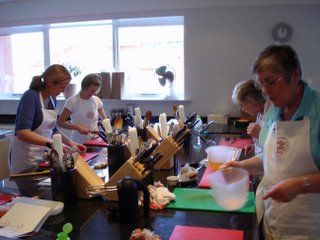 By this time, it was starting to feel rather warm and the coffee and croissant which accompanied our mid-morning break were very welcome. This breather also allowed time to chat with some of the other participants, mainly female, and learn that, for most, this was not their first visit. Indeed, it was their third or fourth time at the School and I was given some friendly warnings that my first foray into this foodie’s paradise was unlikely to be my last.
By this time, it was starting to feel rather warm and the coffee and croissant which accompanied our mid-morning break were very welcome. This breather also allowed time to chat with some of the other participants, mainly female, and learn that, for most, this was not their first visit. Indeed, it was their third or fourth time at the School and I was given some friendly warnings that my first foray into this foodie’s paradise was unlikely to be my last.After the break, we made a pearl barley soup and seemed to chop ‘til we nearly dropped! Francisco, the second trainer, was, however, on hand with encouraging words that the effort would be worth it in the end. My soup certainly looked and smelt good by the end of it all. This is more than can be said for my efforts at rolling out pastry into a neat circle, which was our next task. And I used to be so good with play dough!
 The pastry, once I eventually managed to get it looking mildly curvaceous, was put in the chiller and, in the afternoon, more chopping ensued to fill the pie base with onions and create a divine-looking Swiss Onion Tart. But, before this, we all set to on making lunch – a creamy alpine macaroni dish with bacon lardons, potatoes and raclette cheese. This was served with a lambs lettuce salad and Bettys’ bread, all washed down with a scrumptious glass of Swiss wine. Desert was ‘Engadine’, from the craft bakery – a tasty merengue and nut creation. Rather replete and slightly inebriated, I was very glad my fingers remained in tact as I attacked my onions post-lunch.
The pastry, once I eventually managed to get it looking mildly curvaceous, was put in the chiller and, in the afternoon, more chopping ensued to fill the pie base with onions and create a divine-looking Swiss Onion Tart. But, before this, we all set to on making lunch – a creamy alpine macaroni dish with bacon lardons, potatoes and raclette cheese. This was served with a lambs lettuce salad and Bettys’ bread, all washed down with a scrumptious glass of Swiss wine. Desert was ‘Engadine’, from the craft bakery – a tasty merengue and nut creation. Rather replete and slightly inebriated, I was very glad my fingers remained in tact as I attacked my onions post-lunch.Our fifth dish of the day was a mushroom and onion sauce to take home and serve on warm toast. In fact, I went home with enough food to feed a small army…well, my family at least. Departure was delayed though by yet another round of coffee and cake. As four o’clock rapidly approached it had become very obvious we were not going to be allowed home without a full tummy and full carrier bag of goodies. I, however, managed to go home with two carrier bags full of goodies as I also succumbed to the temptations of the kitchen shop by purchasing my own tools to recreate my Swiss specialities at home.
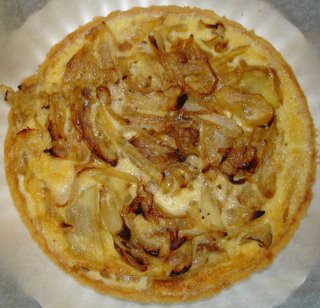 The proof of the pudding comes in the tasting and, all I can say is that the silence which descended over the dinner table later in the evening as my family tucked into the Swiss Onion Tart said it all! Compliments to the chef!
The proof of the pudding comes in the tasting and, all I can say is that the silence which descended over the dinner table later in the evening as my family tucked into the Swiss Onion Tart said it all! Compliments to the chef!For more details of Bettys Cookery School visit: www.bettyscookeryschool.co.uk

